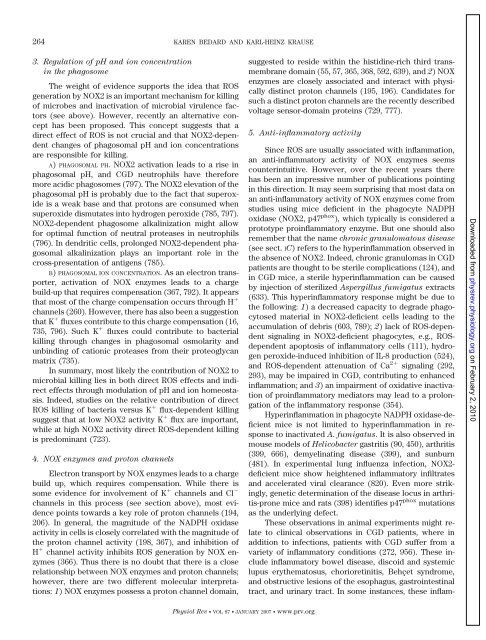Karen Bedard and Karl-Heinz Krause
Karen Bedard and Karl-Heinz Krause
Karen Bedard and Karl-Heinz Krause
Create successful ePaper yourself
Turn your PDF publications into a flip-book with our unique Google optimized e-Paper software.
264 KAREN BEDARD AND KARL-HEINZ KRAUSE<br />
3. Regulation of pH <strong>and</strong> ion concentration<br />
in the phagosome<br />
The weight of evidence supports the idea that ROS<br />
generation by NOX2 is an important mechanism for killing<br />
of microbes <strong>and</strong> inactivation of microbial virulence factors<br />
(see above). However, recently an alternative concept<br />
has been proposed. This concept suggests that a<br />
direct effect of ROS is not crucial <strong>and</strong> that NOX2-dependent<br />
changes of phagosomal pH <strong>and</strong> ion concentrations<br />
are responsible for killing.<br />
A) PHAGOSOMAL PH. NOX2 activation leads to a rise in<br />
phagosomal pH, <strong>and</strong> CGD neutrophils have therefore<br />
more acidic phagosomes (797). The NOX2 elevation of the<br />
phagosomal pH is probably due to the fact that superoxide<br />
is a weak base <strong>and</strong> that protons are consumed when<br />
superoxide dismutates into hydrogen peroxide (785, 797).<br />
NOX2-dependent phagosome alkalinization might allow<br />
for optimal function of neutral proteases in neutrophils<br />
(796). In dendritic cells, prolonged NOX2-dependent phagosomal<br />
alkalinization plays an important role in the<br />
cross-presentation of antigens (785).<br />
B) PHAGOSOMAL ION CONCENTRATION. As an electron transporter,<br />
activation of NOX enzymes leads to a charge<br />
build-up that requires compensation (367, 792). It appears<br />
that most of the charge compensation occurs through H �<br />
channels (260). However, there has also been a suggestion<br />
that K � fluxes contribute to this charge compensation (16,<br />
735, 796). Such K � fluxes could contribute to bacterial<br />
killing through changes in phagosomal osmolarity <strong>and</strong><br />
unbinding of cationic proteases from their proteoglycan<br />
matrix (735).<br />
In summary, most likely the contribution of NOX2 to<br />
microbial killing lies in both direct ROS effects <strong>and</strong> indirect<br />
effects through modulation of pH <strong>and</strong> ion homeostasis.<br />
Indeed, studies on the relative contribution of direct<br />
ROS killing of bacteria versus K � flux-dependent killing<br />
suggest that at low NOX2 activity K � flux are important,<br />
while at high NOX2 activity direct ROS-dependent killing<br />
is predominant (723).<br />
4. NOX enzymes <strong>and</strong> proton channels<br />
Electron transport by NOX enzymes leads to a charge<br />
build up, which requires compensation. While there is<br />
some evidence for involvement of K � channels <strong>and</strong> Cl �<br />
channels in this process (see section above), most evidence<br />
points towards a key role of proton channels (194,<br />
206). In general, the magnitude of the NADPH oxidase<br />
activity in cells is closely correlated with the magnitude of<br />
the proton channel activity (198, 367), <strong>and</strong> inhibition of<br />
H � channel activity inhibits ROS generation by NOX enzymes<br />
(366). Thus there is no doubt that there is a close<br />
relationship between NOX enzymes <strong>and</strong> proton channels;<br />
however, there are two different molecular interpretations:<br />
1) NOX enzymes possess a proton channel domain,<br />
suggested to reside within the histidine-rich third transmembrane<br />
domain (55, 57, 365, 368, 592, 639), <strong>and</strong> 2) NOX<br />
enzymes are closely associated <strong>and</strong> interact with physically<br />
distinct proton channels (195, 196). C<strong>and</strong>idates for<br />
such a distinct proton channels are the recently described<br />
voltage sensor-domain proteins (729, 777).<br />
5. Anti-inflammatory activity<br />
Physiol Rev VOL 87 JANUARY 2007 www.prv.org<br />
Since ROS are usually associated with inflammation,<br />
an anti-inflammatory activity of NOX enzymes seems<br />
counterintuitive. However, over the recent years there<br />
has been an impressive number of publications pointing<br />
in this direction. It may seem surprising that most data on<br />
an anti-inflammatory activity of NOX enzymes come from<br />
studies using mice deficient in the phagocyte NADPH<br />
oxidase (NOX2, p47 phox ), which typically is considered a<br />
prototype proinflammatory enzyme. But one should also<br />
remember that the name chronic granulomatous disease<br />
(see sect. IC) refers to the hyperinflammation observed in<br />
the absence of NOX2. Indeed, chronic granulomas in CGD<br />
patients are thought to be sterile complications (124), <strong>and</strong><br />
in CGD mice, a sterile hyperinflammation can be caused<br />
by injection of sterilized Aspergillus fumigatus extracts<br />
(633). This hyperinflammatory response might be due to<br />
the following: 1) a decreased capacity to degrade phagocytosed<br />
material in NOX2-deficient cells leading to the<br />
accumulation of debris (603, 789); 2) lack of ROS-dependent<br />
signaling in NOX2-deficient phagocytes, e.g., ROSdependent<br />
apoptosis of inflammatory cells (111), hydrogen<br />
peroxide-induced inhibition of IL-8 production (524),<br />
<strong>and</strong> ROS-dependent attenuation of Ca 2� signaling (292,<br />
293), may be impaired in CGD, contributing to enhanced<br />
inflammation; <strong>and</strong> 3) an impairment of oxidative inactivation<br />
of proinflammatory mediators may lead to a prolongation<br />
of the inflammatory response (354).<br />
Hyperinflammation in phagocyte NADPH oxidase-deficient<br />
mice is not limited to hyperinflammation in response<br />
to inactivated A. fumigatus. It is also observed in<br />
mouse models of Helicobacter gastritis (90, 450), arthritis<br />
(399, 666), demyelinating disease (399), <strong>and</strong> sunburn<br />
(481). In experimental lung influenza infection, NOX2deficient<br />
mice show heightened inflammatory infiltrates<br />
<strong>and</strong> accelerated viral clearance (820). Even more strikingly,<br />
genetic determination of the disease locus in arthritis-prone<br />
mice <strong>and</strong> rats (398) identifies p47 phox mutations<br />
as the underlying defect.<br />
These observations in animal experiments might relate<br />
to clinical observations in CGD patients, where in<br />
addition to infections, patients with CGD suffer from a<br />
variety of inflammatory conditions (272, 956). These include<br />
inflammatory bowel disease, discoid <strong>and</strong> systemic<br />
lupus erythematosus, chorioretinitis, Behçet syndrome,<br />
<strong>and</strong> obstructive lesions of the esophagus, gastrointestinal<br />
tract, <strong>and</strong> urinary tract. In some instances, these inflam-<br />
Downloaded from<br />
physrev.physiology.org on February 2, 2010













